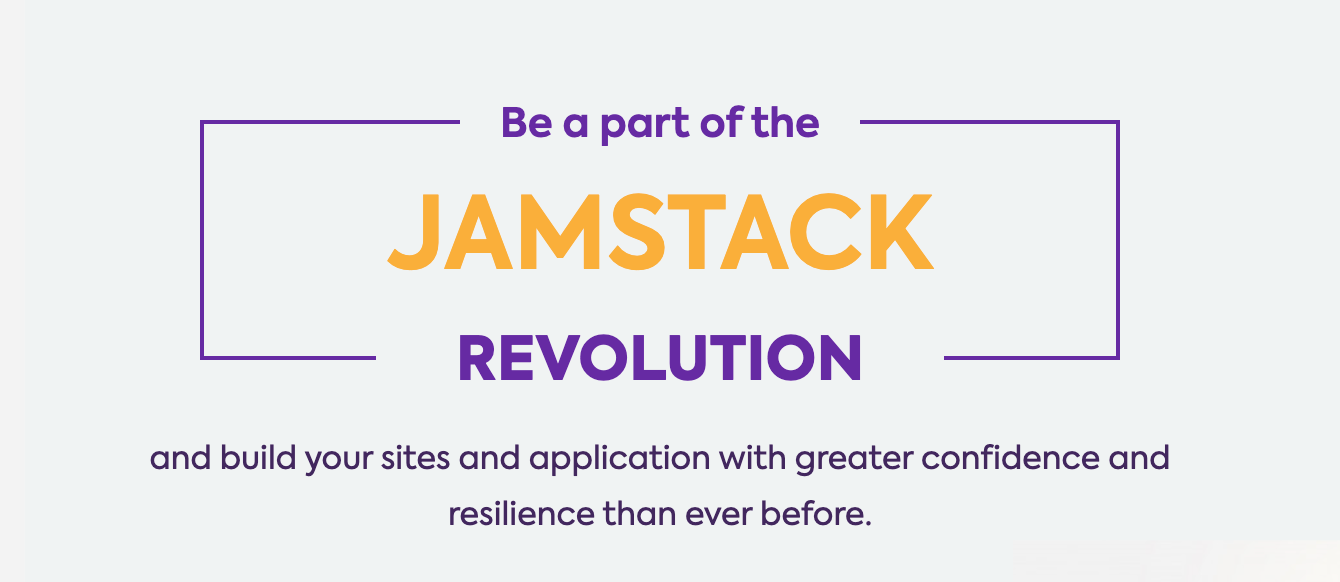What is JAMstack?
Today I will talk about the new modern and next-gen tech architecture to develop websites known as JAMstack.
JAMstack, as the name suggests, stands for JavaScript, APIs, and Markups. It's an architecture that combines multiple technologies to develop websites these days, so it's a developer-first architecture.
JAMstack is designed to make the web faster, more secure, and more scalable.
Why JAMstack?
JAMstack provides incredible benefits like:
- Pre-rendering
- Security
- Scalability
- Performance
- Speed
- Maintainability
- Portability
- Rich Developer Experience
Before going into more detail, let's try to understand why JAMstack is gaining popularity all across the globe.
To answer this, we need to understand the history of developing websites.
History of developing websites
In the early days of the internet, everything was more straightforward than we might think today. The first websites built were just a folder with HTML files that a browser could request. The HTML would determine how the website looked and its content, while the browser's only job was to let the visitor view the page.
As the internet and technologies evolved, we have seen more advanced websites. The first fundamental change here was how content was being served. Static HTML files were no longer enough. Instead, it was necessary to serve customized content to website visitors.
To serve customized content to the visitors, the server had to build HTML of the website at every request. It was a considerable jump from doing simple HTML files. Now the visitors would request a page, and rather than having it ready, the server had to sync with the database and then build up the right content for visitors.
The advantages were clear, more customized content could be served, but that was not all! There were still restrictions because it required more server resources to build, and thus the content would be delivered to the user slower than if it had been an old-school static HTML file.
To solve the legacy problems, Javascript came. The basic logic of JS was to enable the developers to alter the website's content once it's loaded dynamically. That was all!
But there were still problems because of the MPA (Multi-Page Application) + Monolithic architecture because, at each request, Server RTT (Round Trip Time) was high, and thus the page loading speed was still slow for the majority. A classic example is any website built with WordPress, PHP, Java, Net, etc.
Why use the JAMstack architecture?
The whole JAMstack architecture is based on Headless Principal.
You can learn more by visiting the below video:
When to use JAMstack?
Well, the JAMstack is suitable for any website, but it's ideal for :
- Corporate Websites
- SaaS Websites
- Marketing Websites
- Enterprise Websites
- News Websites
- Blogs Websites
- E-commerce landing pages
If you want to change your website content frequently then JAMstack and Headless CMS is the best choice
Below is the video for you to understand more
Technology Selection in JAMstack
JAMstack is architecture so that it can fit with multiple technologies simultaneously. While selecting technology, one needs to understand 3 things:
Static Site Generators are the tech behind presentation layers of the websites in the JAMstack architecture.
We prefer Next JS because it's more stable and has a broader community worldwide. It's built on top of React JS, and its core principles are aligned with React JS, like VDOM, SPA, In-built Routing, etc.
2. Headless CMS (Strapi / Storyblok / Prismic)
Headless CMS (Content Management System) manages the website's contents and is connected to SSGs via REST APIs or GraphQL endpoints.
We always recommend using Headless CMS as per the business use cases.
For Self Hosting --> Strapi (Open Source)
For Cloud Hosting -> Storyblok / Primic / Prismic etc
3. Hosting provider (Vercel / Netlify)
Hosting providers like Vercel and Netlify provides features like 3-click deployment, Pre-configures CI/CD, Edge Functions, Image Optimization, Out of Box Cachings over CDN, and many other features as well.
JAMstack websites are 10x faster than any monolithic architecture websites development technologies like Wordpress, Webflow etc
Conclusion
- JAMstack is the right choice if you need speed, security, and scalability
- Faster Content Management is Possible with Headless CMSs like Strapi / Storyblok
- Static Site Generators like Next JS are used for developing the presentation layer
For more information, you can visit www.jamsfy.com, they are pioneers in developing JAMstack websites.




